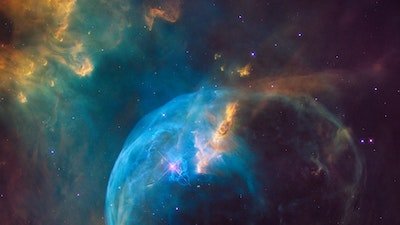
Stardust Latest Suspect for Origin of Life
Spectral signposts suggest interstellar seeds of life.
News Source
- The State Column: “Scientists: Star Dust Could Be Key to Beginning of Life on Earth”
Stardust is the latest source suggested as a supply for complex organic molecules supposed to be the precursors for the evolution of life. Sun Kwok and Yong Zhang from the University of Hong Kong analyzed infrared spectral emissions from circumstellar and interstellar locations. They determined the spectral patterns can be explained by the presence of complex organic molecules.
After being excited by photons of light, molecules can emit energy detectable as electromagnetic emissions. Such spectra act like fingerprints to identify many molecules at a distance. Kwok and Zhang’s analysis of infrared spectra found spectra from over 160 molecules. All of these signatures were consistent with those expected from complex “amorphous organic solids with a mixed aromatic-aliphatic structure.”1
The researchers, describing this stardust in Nature, write that the suspected molecular structures are “similar to that of the organic materials found in meteorites, as would be expected if the Solar System had inherited these organic materials from interstellar sources.”2
What impressed me most is that complex organics are easily formed by stars, they are everywhere in our own galaxy and in other galaxies.
The infrared emissions exceed the complexity of the emissions seen with ordinary aromatic hydrocarbons. While no amino acids or nucleic acid components were found, these organic molecules appear to be similar to those in coal and petroleum.
“What impressed me most is that complex organics are easily formed by stars, they are everywhere in our own galaxy and in other galaxies,” Kwok said. And since the emissions were coming not just from stars themselves but also from interstellar regions, Kwok and Zhang conclude that stars are ejecting the material into space. Therefore, they conclude, this stardust could be the sort of source from which the solar system “inherited these organic materials.”3 “Nature is much more clever than we had imagined,” Kwok added.
Evolutionary cosmology maintains that meteorites are remnants of the solar system’s formation. As such, by assuming organic compounds ejected by stars could have fortified the primordial solar system, asteroids and meteorites, and of course earth with the building blocks of life, evolutionary scientists see such findings as a source to seed the process of molecules-to-man evolution. Kwok explains, “While it may be too soon to determine whether these organic compounds played a role in kick-starting the development of life on Earth, it certainly is a possibility.”
Since organic molecules such as amino acids, keto acids,4 and nucleobases have all been found in meteorites, these stellar findings are not surprising. The same elements that react to form organic compounds under the control of enzymes in living organisms can also react to form such compounds through non-biologic means. The enzymes with which organisms catalyze chemical reactions do not provide the only ways for chemical reactions to take place, just the most efficient ways.
Furthermore, even if a vat of organic molecules sat in the sun forever, they could not organize themselves into life forms having neither the informational blueprint nor that mysterious “spark” of life that biology has yet to explain. Finally, even if such life could evolve from organic soup, the source of the elements comprising the soup would still require a divine starting point.
The Bible tells us God spoke the earth into existence. On the third, fifth, and sixth days of Creation Week, He created the living components of His creation. He made the sun, moon, and stars on the fourth day. Genesis specifies God made Adam from the dust of the ground. God created the same chemistry to operate in both living and non-living things. The chemicals in living things may have a great deal in common with the dust in outer space, but God did not require a space nebula to supply His raw materials.
Further Reading
- Get Answers: Astronomy
For More Information: Get Answers
Remember, if you see a news story that might merit some attention, let us know about it! (Note: if the story originates from the Associated Press, FOX News, MSNBC, the New York Times, or another major national media outlet, we will most likely have already heard about it.) And thanks to all of our readers who have submitted great news tips to us. If you didn’t catch all the latest News to Know, why not take a look to see what you’ve missed?
(Please note that links will take you directly to the source. Answers in Genesis is not responsible for content on the websites to which we refer. For more information, please see our Privacy Policy.)
Footnotes
- Sun Kwok and Yong Zhang, “Mixed Aromatic–Aliphatic Organic Nanoparticles as Carriers of Unidentified Infrared Emission Features,” Nature 479 (November 3, 2011): 80–83, doi:10.1038/nature10542.
- Ibid.
- Ibid.
- George Cooper et al., “Detection and Formation Scenario of Citric Acid, Pyruvic Acid, and Other Possible Metabolism Precursors in Carbonaceous Meteorites,” PNAS 108, no. 34 (August 23, 2011): 14015–14020, doi:10.1073/pnas.1105715108 .
Recommended Resources

Answers in Genesis is an apologetics ministry, dedicated to helping Christians defend their faith and proclaim the good news of Jesus Christ.
- Customer Service 800.778.3390
- © 2024 Answers in Genesis







